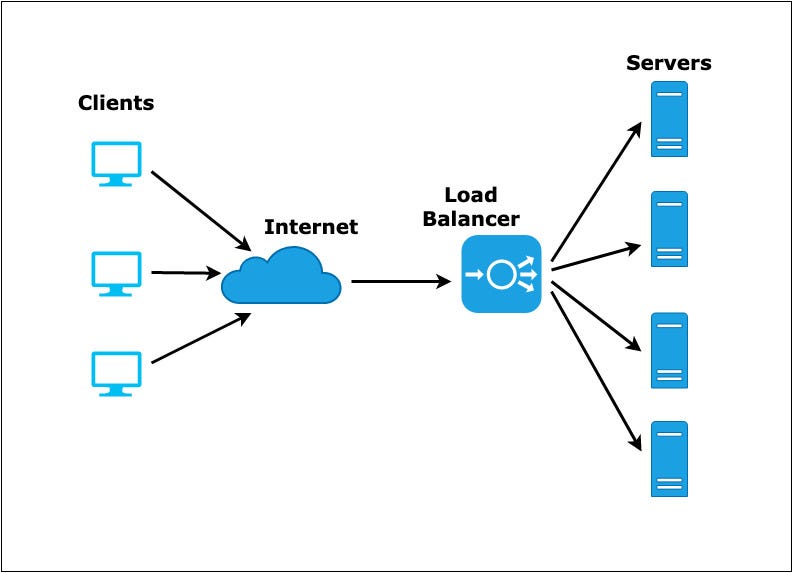Maximizing Website Performance: The Crucial Role of Load Balancers
 Abhinav Singh
Abhinav Singh
In the vast expanse of web servers and network infrastructure, a silent yet indispensable hero tirelessly orchestrates the flow of internet traffic, ensuring seamless experiences for users worldwide. This unsung hero goes by the name of the Load Balancer. Imagine load balancers as traffic managers on a bustling highway, directing cars to prevent congestion in any single lane while maintaining an efficient flow of traffic. In this comprehensive exploration, we'll delve into the world of load balancers, uncovering their significance, types, pros, cons, and real-world analogies.

Understanding the Load Balancer: A Beacon of Efficiency
At its core, a load balancer serves as a mediator between client requests and backend servers, meticulously distributing incoming traffic across multiple servers to enhance reliability, scalability, and performance. Picture a diligent waiter in a bustling restaurant, deftly taking orders from multiple tables and ensuring each receives its fair share of attention from the kitchen. Load balancers operate on a similar principle, intelligently managing traffic to optimize resource utilization and deliver a seamless user experience.
Video Overview: The Role of Load Balancers in Web Infrastructure
Before we delve further, take a moment to watch this insightful video, which provides an overview of load balancers and their critical role in web infrastructure:
Now, armed with a basic understanding, let's delve deeper into the world of load balancers.
The Importance of Load Balancers: Pros and Cons
Pros of Load Balancers:
Enhanced Performance: By evenly distributing traffic, load balancers prevent any single server from becoming overwhelmed, thereby optimizing response times and improving overall performance.
High Availability: Load balancers can reroute traffic away from failed or underperforming servers, ensuring uninterrupted service and maximizing uptime.
Scalability: As demand fluctuates, load balancers dynamically allocate resources to accommodate varying traffic loads, allowing organizations to scale their infrastructure seamlessly.
Security: Load balancers play a crucial role in enhancing security by performing tasks such as SSL termination, DDoS mitigation, and web application firewalling, thus safeguarding against malicious attacks and ensuring data integrity.
Session Persistence: Some load balancers maintain session affinity, ensuring that subsequent requests from a user are directed to the same backend server, facilitating session management and preserving user state.
Cons of Load Balancers:
Single Point of Failure: While load balancers enhance reliability, if the load balancer itself fails, it can disrupt traffic flow and impact the availability of services.
Increased Complexity: Implementing and managing load balancers adds complexity to the network infrastructure, requiring expertise and careful configuration to ensure optimal performance and reliability.
Cost: High-performance load balancers and redundant setups can incur significant costs, particularly for organizations operating at scale or requiring specialized features and capabilities.
Exploring Load Balancer Types: From Hardware to Cloud Solutions
Load balancers come in various forms, each offering unique features and capabilities tailored to specific use cases. Let's explore the four primary types of load balancers:
1. Hardware Load Balancers:
These are dedicated physical devices optimized for load-balancing tasks, offering high-performance capabilities and specialized features.
Examples include F5 Big-IP and Citrix NetScaler, which are widely used in enterprise environments for their robustness and scalability.
2. Software Load Balancers:
These are software-based solutions running on commodity hardware or virtual machines, offering flexibility and cost-effectiveness.
Popular examples include HAProxy and Nginx, which are widely deployed in cloud and on-premises environments for their versatility and ease of deployment.
3. Cloud Load Balancers:
Offered by leading cloud service providers such as AWS, Google Cloud, and Azure, these load balancers are fully managed and scalable, providing seamless integration with cloud-native environments.
Examples include AWS Elastic Load Balancing (ELB) and Google Cloud Load Balancing, which offer auto-scaling capabilities and built-in redundancy for high availability.
4. DNS Load Balancers:
These distribute traffic at the DNS level by resolving domain names to multiple IP addresses, offering flexibility and global load balancing capabilities.
Examples include Amazon Route 53 and Cloudflare Load Balancer, which leverage DNS-based routing algorithms to distribute traffic intelligently and optimize performance.
Real-Life Analogy: The Pizza Party Scenario
To illustrate the role of load balancers in a real-world context, let's consider a familiar scenario: a bustling pizza party. Initially, there's only one chef tasked with making pizzas, and as the number of hungry guests grows, the overwhelmed chef struggles to keep up with orders, resulting in long wait times and frustrated guests. Now, imagine a savvy organizer steps in and hires additional chefs, along with a coordinator to evenly distribute orders among them. Suddenly, pizzas are flying out of the kitchen at a steady pace, everyone's happy, and the party becomes a resounding success. In this scenario, the load balancer is akin to the coordinator, efficiently managing resources to meet demand and ensure a delightful experience for all.
Conclusion: Empowering Web Infrastructure with Load Balancers
In conclusion, load balancers serve as indispensable components of modern web infrastructure, optimizing performance, reliability, and scalability for organizations of all sizes. By intelligently distributing traffic across multiple servers, load balancers ensure a seamless user experience, much like a skilled conductor orchestrating a symphony of servers. So, the next time you enjoy a smooth, uninterrupted online experience, remember to thank the silent hero working behind the scenes – the mighty load balancer.
Whether you're operating a small website
or a global enterprise, harnessing the power of load balancers can transform your web infrastructure, enhancing efficiency, resilience, and user satisfaction. As technology continues to evolve, load balancers will remain a cornerstone of web architecture, empowering organizations to navigate the complexities of the digital landscape with confidence and grace.
Subscribe to my newsletter
Read articles from Abhinav Singh directly inside your inbox. Subscribe to the newsletter, and don't miss out.
Written by

